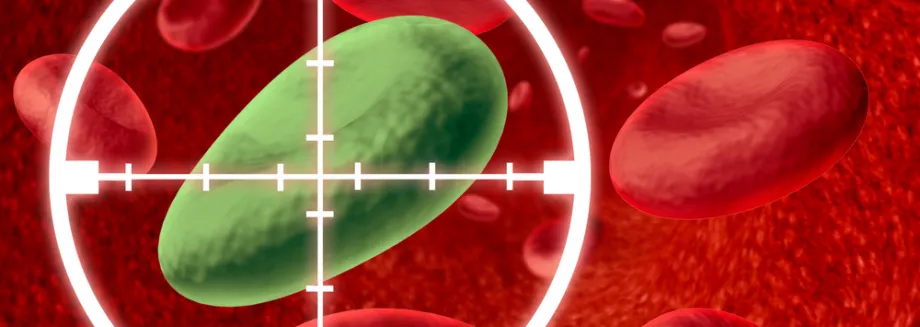
Photo by Lightspring, Shutterstock: Stanford scientists are working on a drug that targets viruses like Ebola, dengue and Zika, which use RNA rather than DNA as their genetic material.
Stanford Medicine News Center - March 28th, 2016 - by Amy Adams
Viruses have proven to be wily foes. Attempts to fend off viruses causing even the common cold or flu have failed, and new viral outbreaks such as dengue, Ebola or Zika continue to elude drugs.
Given these challenges, a group at Stanford is tackling the problem from a different angle: boosting the human body’s ability to resist the virus rather than taking on the virus directly. This approach has paid off with a drug that, in cells in a lab dish at least, helps fight two disease-causing viruses and potentially many more. The work was published March 28 in Nature Chemical Biology.
Chaitan Khosla, PhD, a professor of chemistry and of chemical engineering who was one of the senior authors on the paper, said the way the drug works suggests that it could be broadly effective against viruses that use RNA rather than DNA as their genetic material.
“Most of the really nasty viruses use RNA,” Khosla said, including Ebola, dengue, Zika and Venezuelan equine encephalitis virus, or VEEV, a mosquito-borne virus that infects horses but can also kill people.
Khosla cautioned that at this stage the team has only shown that the drug is effective in a lab dish and on certain viruses. They plan to test their strategy in animals next to learn whether it is safe and to understand which viral diseases it is most effective against.
A new strategy
This project came about when Jeffrey Glenn, MD, PhD, associate professor of medicine and of microbiology and immunology, founded the ViRX@Stanford center through a grant from the National Institute of Allergy and Infectious Diseases in collaboration with Stanford ChEM-H, which Khosla directs. The center’s goal is to develop antiviral strategies targeting human cells rather than the virus.
Scientists typically take a “one drug, one bug” approach to fighting viruses. Glenn’s center, however, has a goal of “one drug, multiple bugs.”
The team had known about a drug being developed by GlaxoSmithKline that appeared to work along these lines, helping human cells fight viruses. However, after a few initial publications the drug got shelved. Khosla thought that with the help of collaborations formed through Glenn’s new center, it might be possible to understand the drug’s mechanism and possibly improve upon it, resurrecting the drug from the shelves and delivering it to patients.
Chemistry graduate student Richard Deans started testing that drug on human cells in a lab dish and found that it enabled the cells to fight off viruses that cause either dengue or VEEV, both of which normally kill the cells. These viruses were chosen because they represent a serious threat to human health, and also represent two different classes of RNA viruses and would test the drug's breadth, according to Jan Carette, PhD, assistant professor of microbiology and immunology and an author on the paper.
Although the drug was effective at fighting the viruses, Deans found that over time the drug also caused the human cells to stop dividing.
Unexpected insights
As a first step to improving on the drug, Deans needed to figure out how it worked. For that, he turned to Michael Bassik, PhD, assistant professor of genetics and a senior author on the paper.
Bassik, who is also member of Stanford Bio-X and ChEM-H, had developed a powerful new way of screening every gene in a cell to identify which proteins those genes produce to carry out a particular behavior, like responding to a drug.
From this screen, the team learned that the drug interferes with a protein that is crucial for making the individual building blocks of RNA, the genetic code for the virus. Without RNA the virus can't make more of itself, which explains why the drug was so effective.
However, because of the way the screen was designed, it also revealed two important additional details that the team wouldn’t have otherwise known: why the drug doesn’t work perfectly and why it causes cells to stop dividing. That information gave the team a way of reducing the drug’s side effects and also suggested a way of making it more effective.
“The genome-wide screen carried out in the Bassik lab was really powerful, because it gave us insights into future research strategies,” said Deans, who was lead author of the paper. “I think going forward his strategy will be much more heavily used.”
Cells also need RNA, and can get RNA building blocks in two ways — by making them or by importing them from the bloodstream. The drug blocked the cell’s ability to make the RNA building blocks but left intact the cell’s ability to import them. Without disrupting both pathways, some RNA precursors made it into the cell and were available to the virus.
Ayşe Ökesli, PhD, a joint postdoctoral fellow in the Bassik and Khosla labs, said the team is now testing their drug along with another one that is known to block the import pathway to see if the combination is more effective than one drug alone, and to be sure human cells aren’t damaged by the absence of RNA building blocks.
Less toxic
Knowing how the drug worked also explained why it caused the body’s normal, healthy cells to stop dividing. The same building blocks needed for RNA synthesis are also needed to make DNA, the cell’s genetic code that it replicates with each division to carry out business as usual. When a cell runs out of DNA building blocks, it can no longer divide.
Knowing the problem, the team could devise a solution. They fed the cells a slightly different building block that can only be used to generate DNA, not RNA. With that added to the mix, the cells successfully fought off both dengue and VEEV and were able to keep dividing normally. This knowledge could help make the drug less toxic in animals and eventually people.
Khosla said they plan to test the drug combination against many different RNA viruses to learn which it fights most effectively. If the drug combination is successful in animals, they hope it might become among the first broad antiviral strategies for human disease.
The research was funded by the National Science Foundation Graduate Research Fellowship, a Burt and Deedee McMurtry Stanford Graduate Fellowship, the National Institutes of Health, an NIH Director’s New Innovator Award Program and a seed grant from Stanford ChEM-H.




